Business Process Modelling: Marketing & Advertising Analysis Report
VerifiedAdded on 2022/09/13
|13
|2168
|21
Report
AI Summary
This report provides a comprehensive analysis of marketing and advertising processes, focusing on five key areas: social media marketing (SMM), content marketing, user engagement and conversion, website/app optimization, and lead generation. It delves into the importance of these processes in enhancing sales and profitability, outlining the steps involved in each, and highlighting the role of stakeholders. The report further explores how automation and technology can improve these processes, with examples of tools like Sprout Social and AI. Finally, it discusses methods for measuring an organization's process maturity in these areas, concluding with insights on the significance of these processes for competitive success. The report, contributed by a student, is designed to help students understand and apply effective marketing strategies.
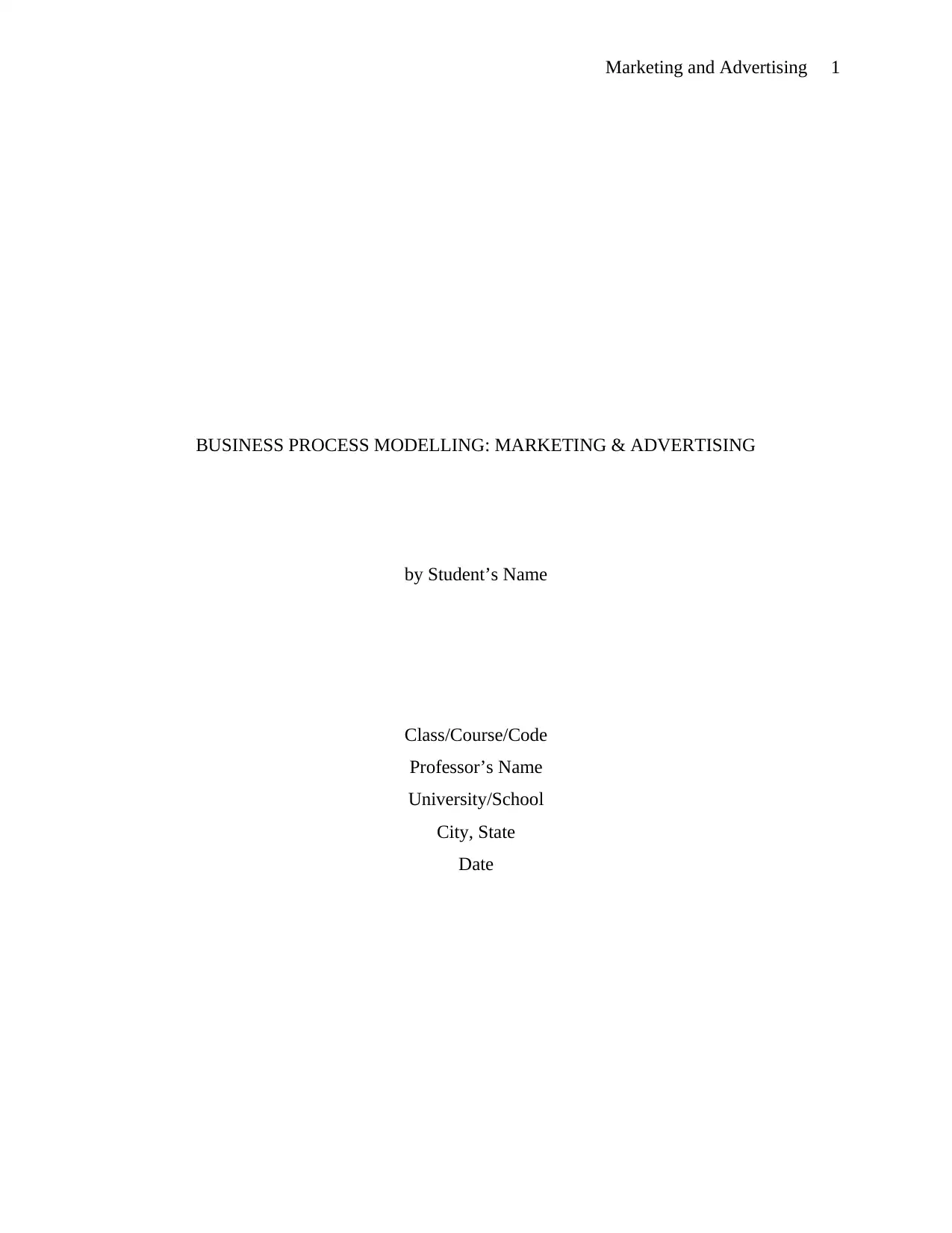
Marketing and Advertising 1
BUSINESS PROCESS MODELLING: MARKETING & ADVERTISING
by Student’s Name
Class/Course/Code
Professor’s Name
University/School
City, State
Date
BUSINESS PROCESS MODELLING: MARKETING & ADVERTISING
by Student’s Name
Class/Course/Code
Professor’s Name
University/School
City, State
Date
Paraphrase This Document
Need a fresh take? Get an instant paraphrase of this document with our AI Paraphraser
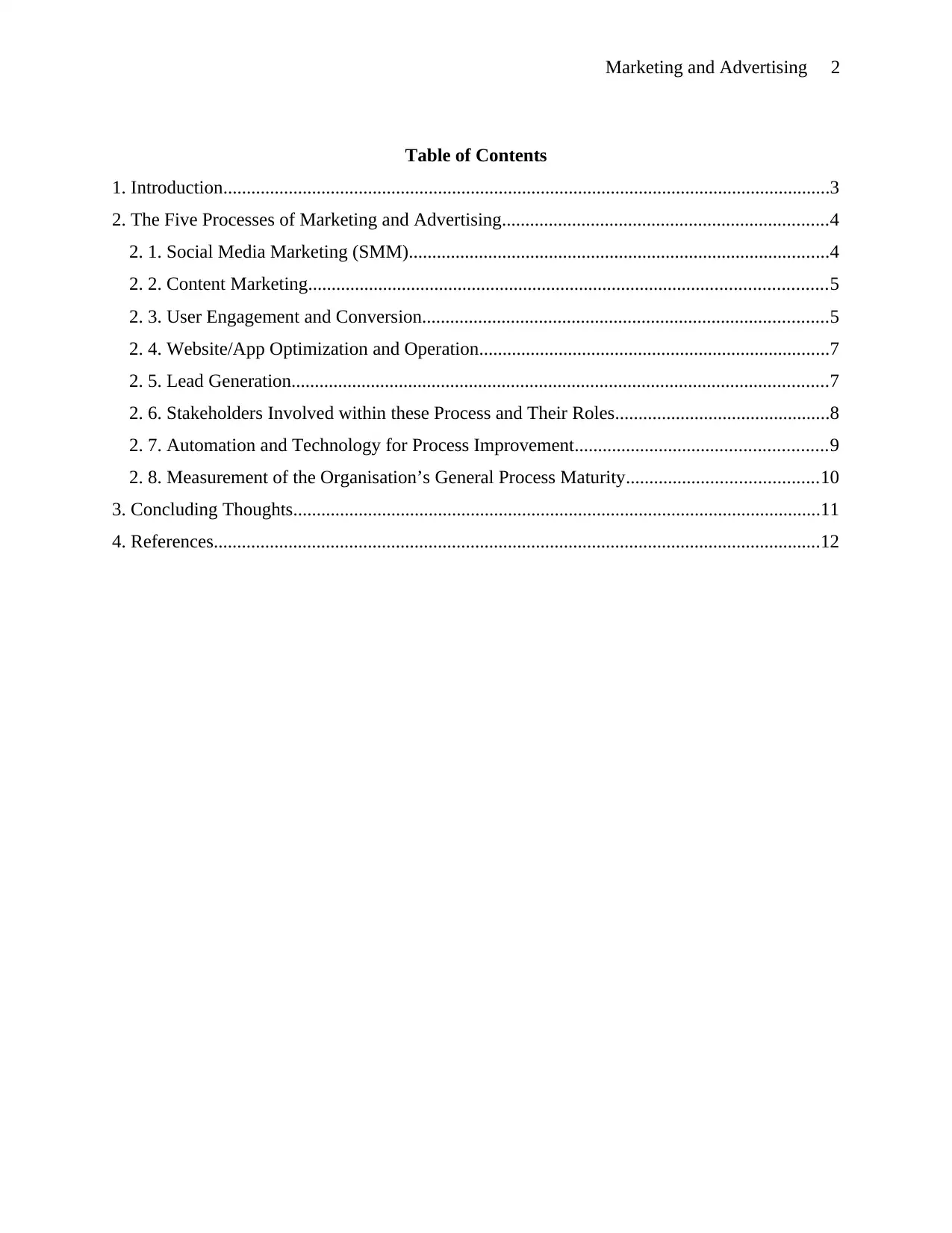
Marketing and Advertising 2
Table of Contents
1. Introduction..................................................................................................................................3
2. The Five Processes of Marketing and Advertising......................................................................4
2. 1. Social Media Marketing (SMM)..........................................................................................4
2. 2. Content Marketing...............................................................................................................5
2. 3. User Engagement and Conversion.......................................................................................5
2. 4. Website/App Optimization and Operation...........................................................................7
2. 5. Lead Generation...................................................................................................................7
2. 6. Stakeholders Involved within these Process and Their Roles..............................................8
2. 7. Automation and Technology for Process Improvement......................................................9
2. 8. Measurement of the Organisation’s General Process Maturity.........................................10
3. Concluding Thoughts.................................................................................................................11
4. References..................................................................................................................................12
Table of Contents
1. Introduction..................................................................................................................................3
2. The Five Processes of Marketing and Advertising......................................................................4
2. 1. Social Media Marketing (SMM)..........................................................................................4
2. 2. Content Marketing...............................................................................................................5
2. 3. User Engagement and Conversion.......................................................................................5
2. 4. Website/App Optimization and Operation...........................................................................7
2. 5. Lead Generation...................................................................................................................7
2. 6. Stakeholders Involved within these Process and Their Roles..............................................8
2. 7. Automation and Technology for Process Improvement......................................................9
2. 8. Measurement of the Organisation’s General Process Maturity.........................................10
3. Concluding Thoughts.................................................................................................................11
4. References..................................................................................................................................12
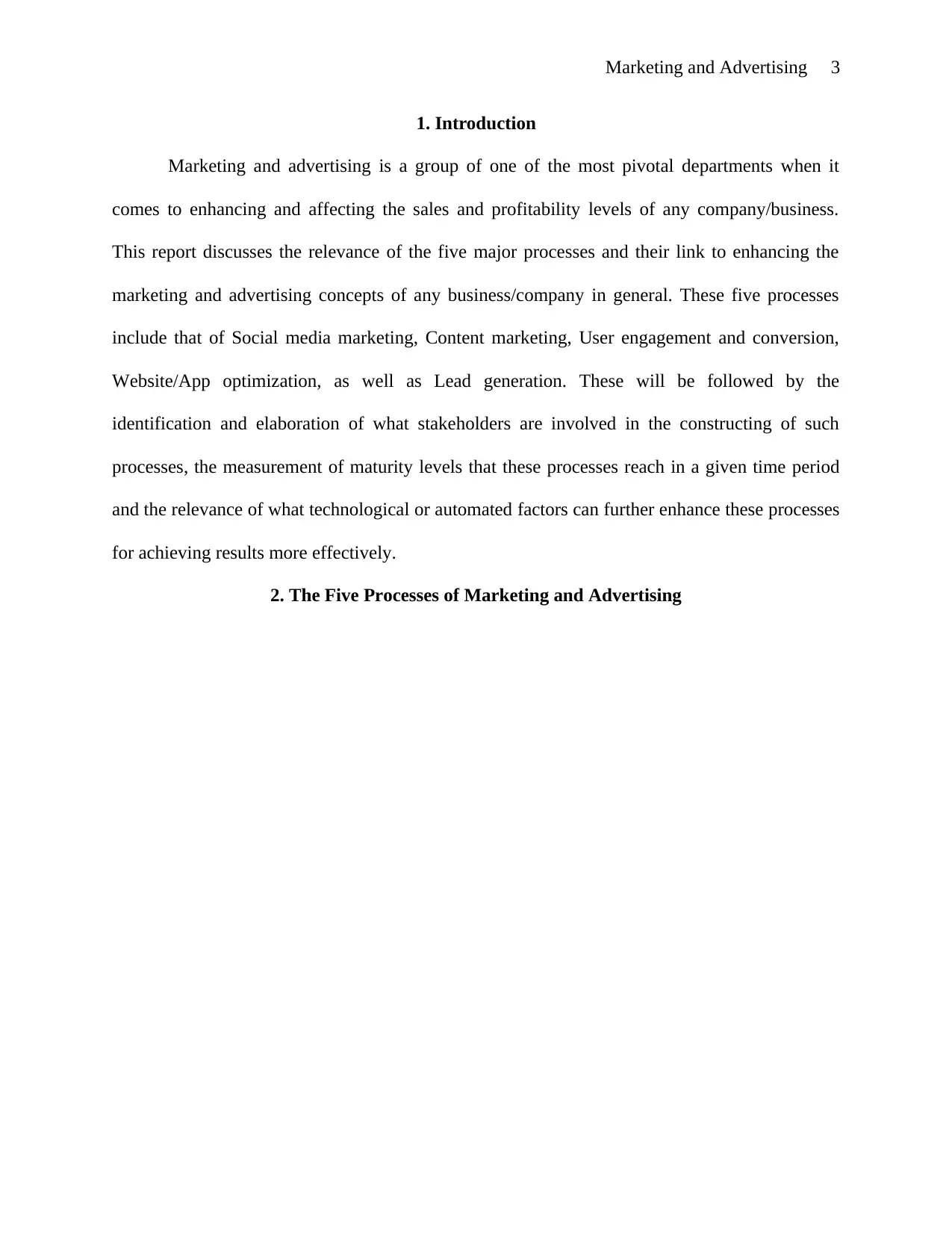
Marketing and Advertising 3
1. Introduction
Marketing and advertising is a group of one of the most pivotal departments when it
comes to enhancing and affecting the sales and profitability levels of any company/business.
This report discusses the relevance of the five major processes and their link to enhancing the
marketing and advertising concepts of any business/company in general. These five processes
include that of Social media marketing, Content marketing, User engagement and conversion,
Website/App optimization, as well as Lead generation. These will be followed by the
identification and elaboration of what stakeholders are involved in the constructing of such
processes, the measurement of maturity levels that these processes reach in a given time period
and the relevance of what technological or automated factors can further enhance these processes
for achieving results more effectively.
2. The Five Processes of Marketing and Advertising
1. Introduction
Marketing and advertising is a group of one of the most pivotal departments when it
comes to enhancing and affecting the sales and profitability levels of any company/business.
This report discusses the relevance of the five major processes and their link to enhancing the
marketing and advertising concepts of any business/company in general. These five processes
include that of Social media marketing, Content marketing, User engagement and conversion,
Website/App optimization, as well as Lead generation. These will be followed by the
identification and elaboration of what stakeholders are involved in the constructing of such
processes, the measurement of maturity levels that these processes reach in a given time period
and the relevance of what technological or automated factors can further enhance these processes
for achieving results more effectively.
2. The Five Processes of Marketing and Advertising
You're viewing a preview
Unlock full access by subscribing today!
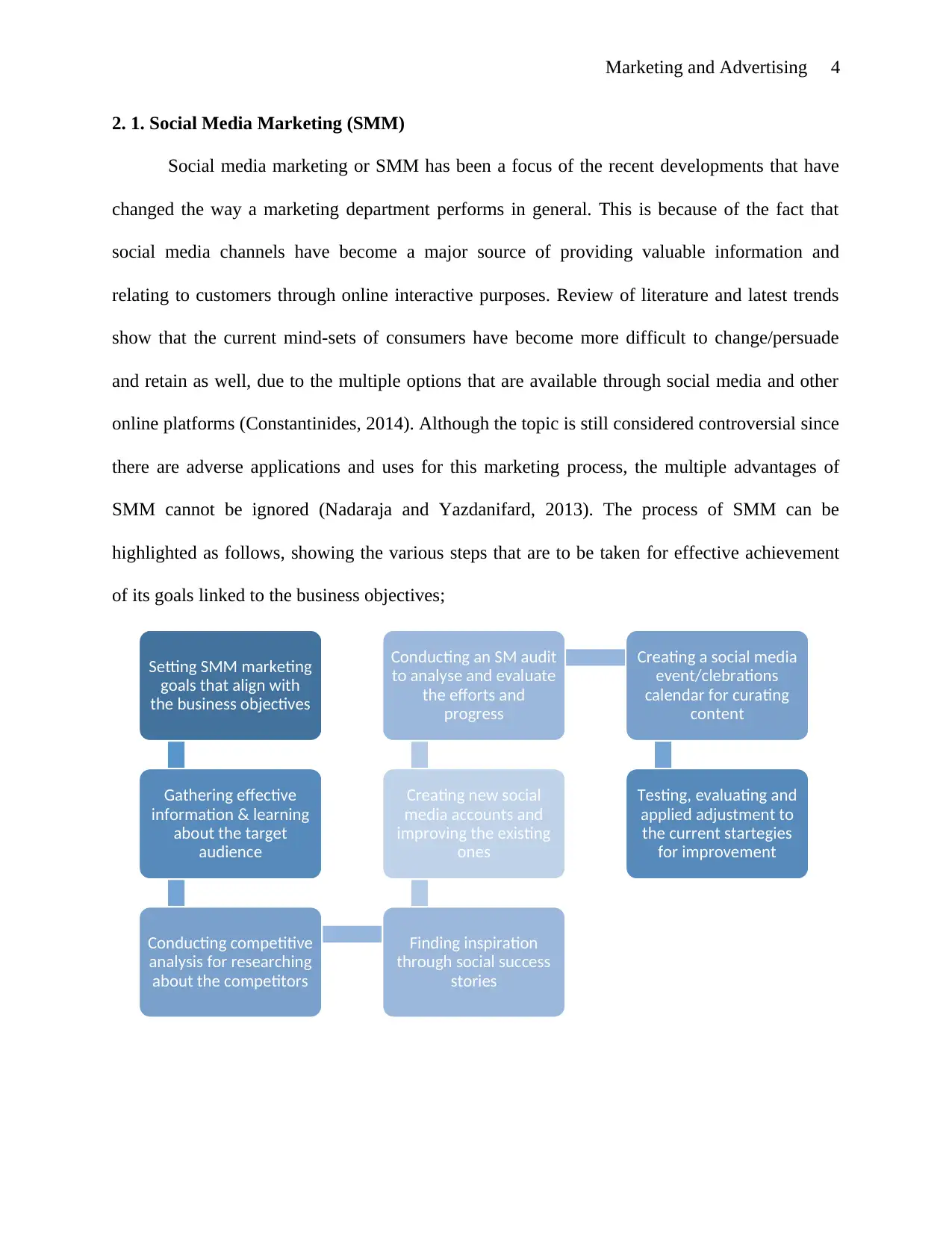
Marketing and Advertising 4
2. 1. Social Media Marketing (SMM)
Social media marketing or SMM has been a focus of the recent developments that have
changed the way a marketing department performs in general. This is because of the fact that
social media channels have become a major source of providing valuable information and
relating to customers through online interactive purposes. Review of literature and latest trends
show that the current mind-sets of consumers have become more difficult to change/persuade
and retain as well, due to the multiple options that are available through social media and other
online platforms (Constantinides, 2014). Although the topic is still considered controversial since
there are adverse applications and uses for this marketing process, the multiple advantages of
SMM cannot be ignored (Nadaraja and Yazdanifard, 2013). The process of SMM can be
highlighted as follows, showing the various steps that are to be taken for effective achievement
of its goals linked to the business objectives;
Setting SMM marketing
goals that align with
the business objectives
Gathering effective
information & learning
about the target
audience
Conducting competitive
analysis for researching
about the competitors
Finding inspiration
through social success
stories
Creating new social
media accounts and
improving the existing
ones
Conducting an SM audit
to analyse and evaluate
the efforts and
progress
Creating a social media
event/clebrations
calendar for curating
content
Testing, evaluating and
applied adjustment to
the current startegies
for improvement
2. 1. Social Media Marketing (SMM)
Social media marketing or SMM has been a focus of the recent developments that have
changed the way a marketing department performs in general. This is because of the fact that
social media channels have become a major source of providing valuable information and
relating to customers through online interactive purposes. Review of literature and latest trends
show that the current mind-sets of consumers have become more difficult to change/persuade
and retain as well, due to the multiple options that are available through social media and other
online platforms (Constantinides, 2014). Although the topic is still considered controversial since
there are adverse applications and uses for this marketing process, the multiple advantages of
SMM cannot be ignored (Nadaraja and Yazdanifard, 2013). The process of SMM can be
highlighted as follows, showing the various steps that are to be taken for effective achievement
of its goals linked to the business objectives;
Setting SMM marketing
goals that align with
the business objectives
Gathering effective
information & learning
about the target
audience
Conducting competitive
analysis for researching
about the competitors
Finding inspiration
through social success
stories
Creating new social
media accounts and
improving the existing
ones
Conducting an SM audit
to analyse and evaluate
the efforts and
progress
Creating a social media
event/clebrations
calendar for curating
content
Testing, evaluating and
applied adjustment to
the current startegies
for improvement
Paraphrase This Document
Need a fresh take? Get an instant paraphrase of this document with our AI Paraphraser
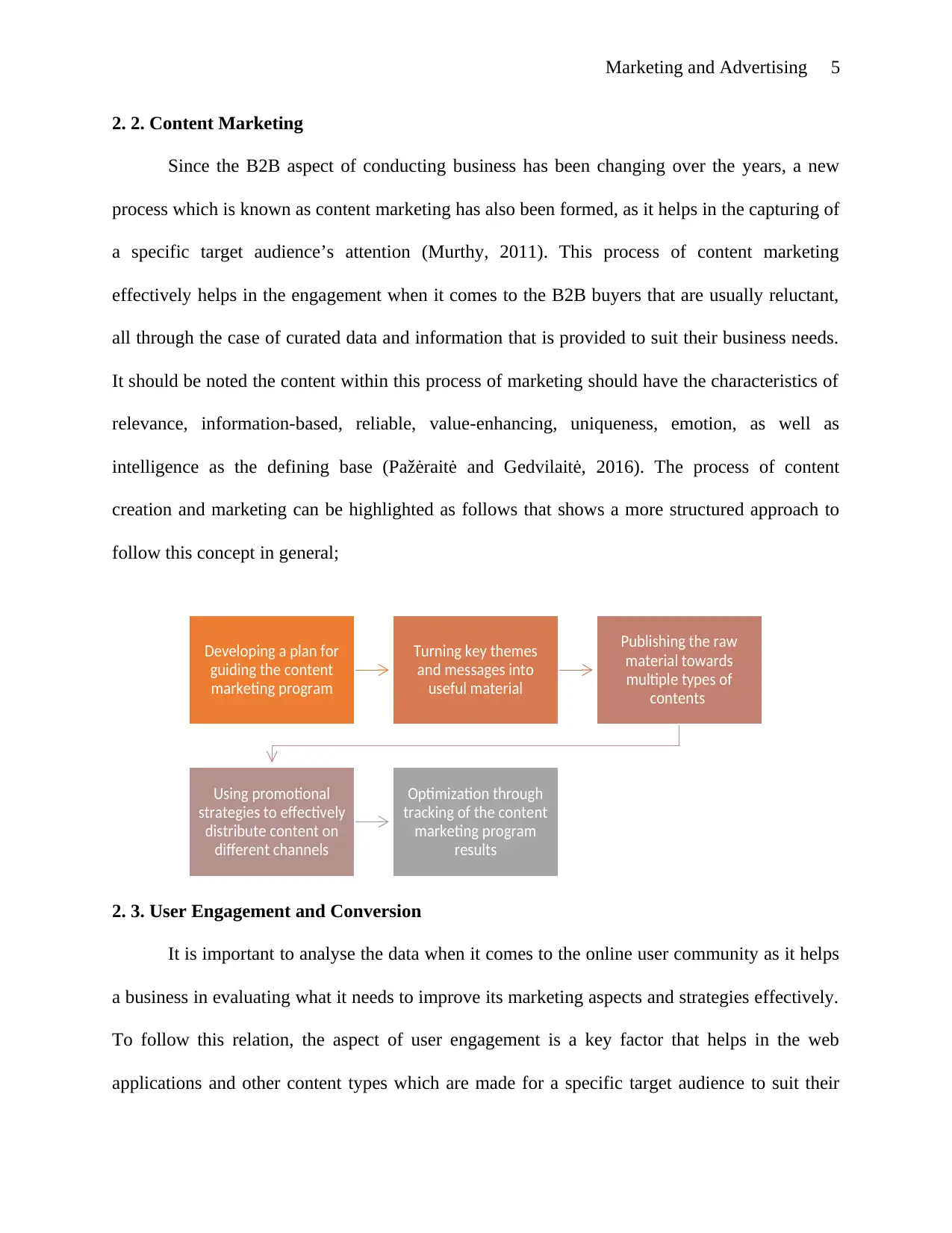
Marketing and Advertising 5
2. 2. Content Marketing
Since the B2B aspect of conducting business has been changing over the years, a new
process which is known as content marketing has also been formed, as it helps in the capturing of
a specific target audience’s attention (Murthy, 2011). This process of content marketing
effectively helps in the engagement when it comes to the B2B buyers that are usually reluctant,
all through the case of curated data and information that is provided to suit their business needs.
It should be noted the content within this process of marketing should have the characteristics of
relevance, information-based, reliable, value-enhancing, uniqueness, emotion, as well as
intelligence as the defining base (Pažėraitė and Gedvilaitė, 2016). The process of content
creation and marketing can be highlighted as follows that shows a more structured approach to
follow this concept in general;
2. 3. User Engagement and Conversion
It is important to analyse the data when it comes to the online user community as it helps
a business in evaluating what it needs to improve its marketing aspects and strategies effectively.
To follow this relation, the aspect of user engagement is a key factor that helps in the web
applications and other content types which are made for a specific target audience to suit their
Developing a plan for
guiding the content
marketing program
Turning key themes
and messages into
useful material
Publishing the raw
material towards
multiple types of
contents
Using promotional
strategies to effectively
distribute content on
different channels
Optimization through
tracking of the content
marketing program
results
2. 2. Content Marketing
Since the B2B aspect of conducting business has been changing over the years, a new
process which is known as content marketing has also been formed, as it helps in the capturing of
a specific target audience’s attention (Murthy, 2011). This process of content marketing
effectively helps in the engagement when it comes to the B2B buyers that are usually reluctant,
all through the case of curated data and information that is provided to suit their business needs.
It should be noted the content within this process of marketing should have the characteristics of
relevance, information-based, reliable, value-enhancing, uniqueness, emotion, as well as
intelligence as the defining base (Pažėraitė and Gedvilaitė, 2016). The process of content
creation and marketing can be highlighted as follows that shows a more structured approach to
follow this concept in general;
2. 3. User Engagement and Conversion
It is important to analyse the data when it comes to the online user community as it helps
a business in evaluating what it needs to improve its marketing aspects and strategies effectively.
To follow this relation, the aspect of user engagement is a key factor that helps in the web
applications and other content types which are made for a specific target audience to suit their
Developing a plan for
guiding the content
marketing program
Turning key themes
and messages into
useful material
Publishing the raw
material towards
multiple types of
contents
Using promotional
strategies to effectively
distribute content on
different channels
Optimization through
tracking of the content
marketing program
results
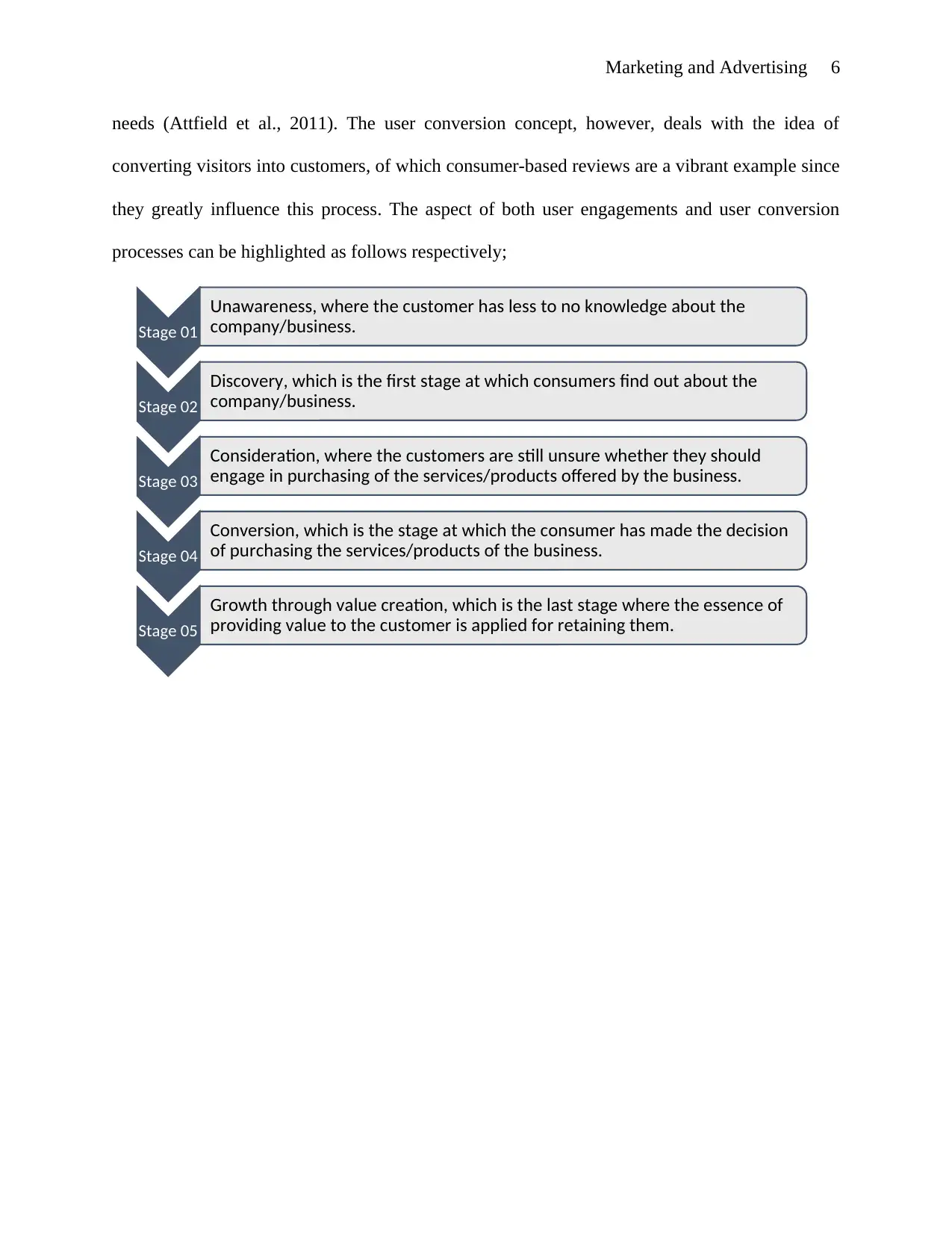
Marketing and Advertising 6
needs (Attfield et al., 2011). The user conversion concept, however, deals with the idea of
converting visitors into customers, of which consumer-based reviews are a vibrant example since
they greatly influence this process. The aspect of both user engagements and user conversion
processes can be highlighted as follows respectively;
Stage 01
Unawareness, where the customer has less to no knowledge about the
company/business.
Stage 02
Discovery, which is the first stage at which consumers find out about the
company/business.
Stage 03
Consideration, where the customers are still unsure whether they should
engage in purchasing of the services/products offered by the business.
Stage 04
Conversion, which is the stage at which the consumer has made the decision
of purchasing the services/products of the business.
Stage 05
Growth through value creation, which is the last stage where the essence of
providing value to the customer is applied for retaining them.
needs (Attfield et al., 2011). The user conversion concept, however, deals with the idea of
converting visitors into customers, of which consumer-based reviews are a vibrant example since
they greatly influence this process. The aspect of both user engagements and user conversion
processes can be highlighted as follows respectively;
Stage 01
Unawareness, where the customer has less to no knowledge about the
company/business.
Stage 02
Discovery, which is the first stage at which consumers find out about the
company/business.
Stage 03
Consideration, where the customers are still unsure whether they should
engage in purchasing of the services/products offered by the business.
Stage 04
Conversion, which is the stage at which the consumer has made the decision
of purchasing the services/products of the business.
Stage 05
Growth through value creation, which is the last stage where the essence of
providing value to the customer is applied for retaining them.
You're viewing a preview
Unlock full access by subscribing today!
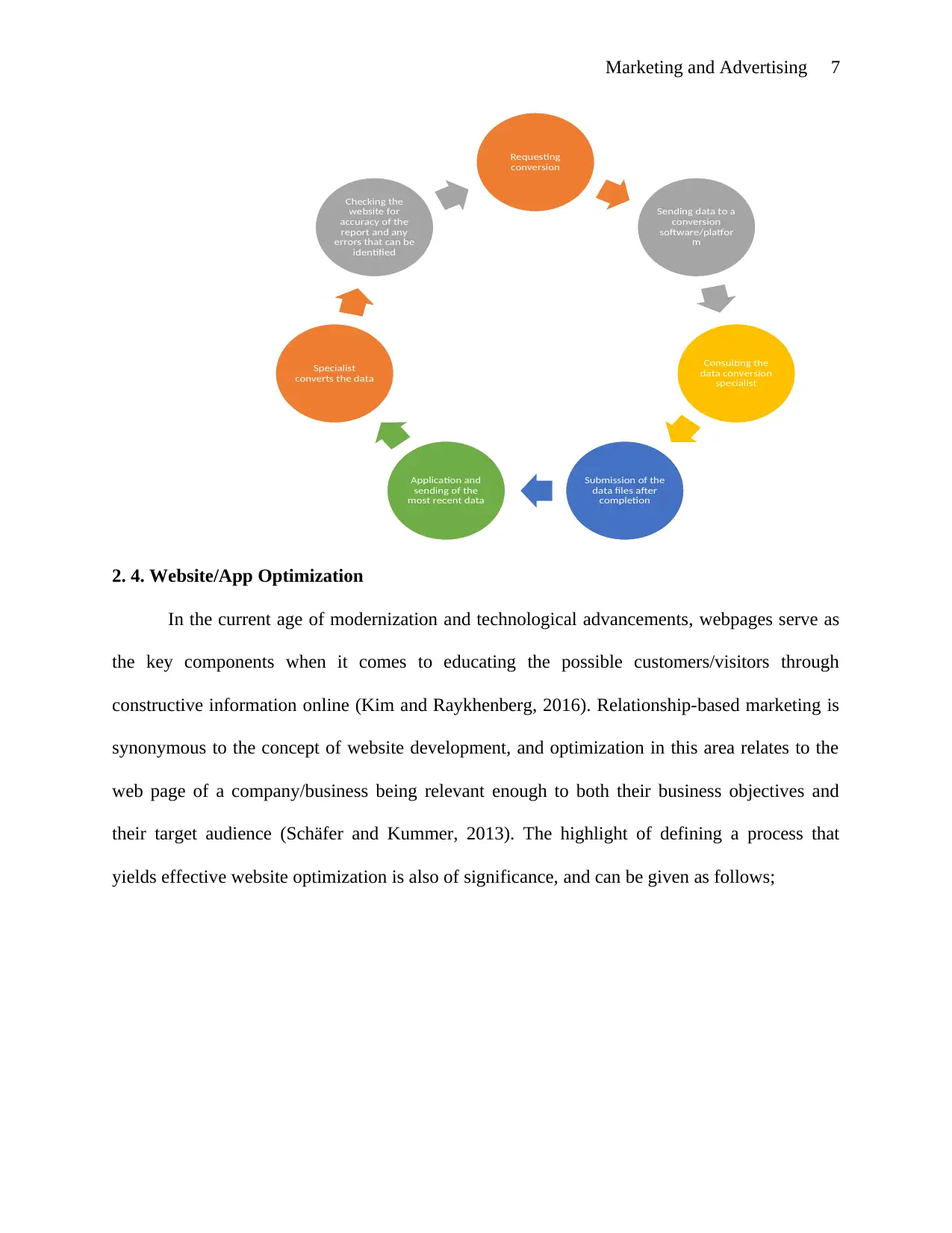
Marketing and Advertising 7
2. 4. Website/App Optimization
In the current age of modernization and technological advancements, webpages serve as
the key components when it comes to educating the possible customers/visitors through
constructive information online (Kim and Raykhenberg, 2016). Relationship-based marketing is
synonymous to the concept of website development, and optimization in this area relates to the
web page of a company/business being relevant enough to both their business objectives and
their target audience (Schäfer and Kummer, 2013). The highlight of defining a process that
yields effective website optimization is also of significance, and can be given as follows;
Requesting
conversion
Sending data to a
conversion
software/platfor
m
Consulting the
data conversion
specialist
Submission of the
data files after
completion
Application and
sending of the
most recent data
Specialist
converts the data
Checking the
website for
accuracy of the
report and any
errors that can be
identified
2. 4. Website/App Optimization
In the current age of modernization and technological advancements, webpages serve as
the key components when it comes to educating the possible customers/visitors through
constructive information online (Kim and Raykhenberg, 2016). Relationship-based marketing is
synonymous to the concept of website development, and optimization in this area relates to the
web page of a company/business being relevant enough to both their business objectives and
their target audience (Schäfer and Kummer, 2013). The highlight of defining a process that
yields effective website optimization is also of significance, and can be given as follows;
Requesting
conversion
Sending data to a
conversion
software/platfor
m
Consulting the
data conversion
specialist
Submission of the
data files after
completion
Application and
sending of the
most recent data
Specialist
converts the data
Checking the
website for
accuracy of the
report and any
errors that can be
identified
Paraphrase This Document
Need a fresh take? Get an instant paraphrase of this document with our AI Paraphraser
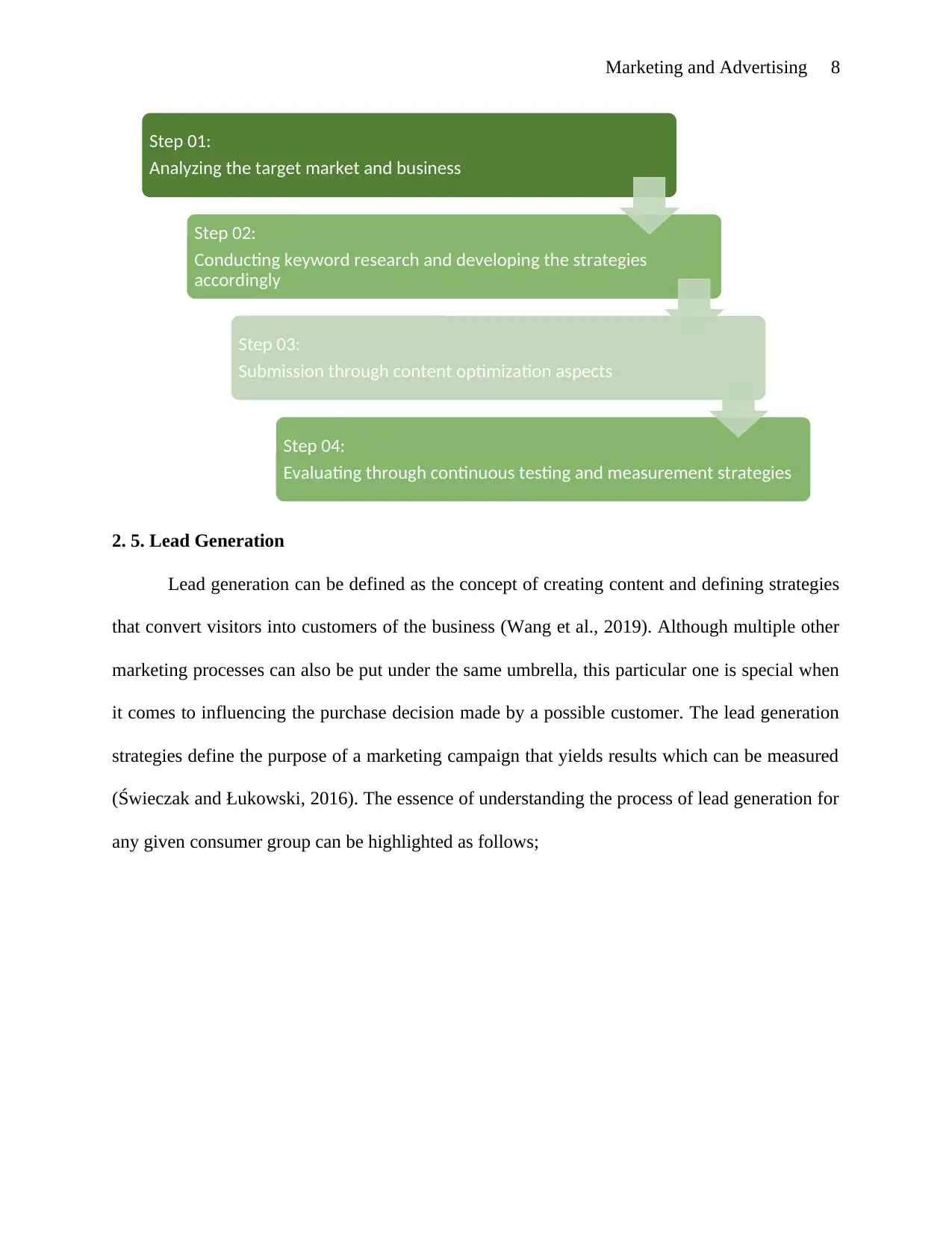
Marketing and Advertising 8
2. 5. Lead Generation
Lead generation can be defined as the concept of creating content and defining strategies
that convert visitors into customers of the business (Wang et al., 2019). Although multiple other
marketing processes can also be put under the same umbrella, this particular one is special when
it comes to influencing the purchase decision made by a possible customer. The lead generation
strategies define the purpose of a marketing campaign that yields results which can be measured
(Świeczak and Łukowski, 2016). The essence of understanding the process of lead generation for
any given consumer group can be highlighted as follows;
Step 01:
Analyzing the target market and business
Step 02:
Conducting keyword research and developing the strategies
accordingly
Step 03:
Submission through content optimization aspects
Step 04:
Evaluating through continuous testing and measurement strategies
2. 5. Lead Generation
Lead generation can be defined as the concept of creating content and defining strategies
that convert visitors into customers of the business (Wang et al., 2019). Although multiple other
marketing processes can also be put under the same umbrella, this particular one is special when
it comes to influencing the purchase decision made by a possible customer. The lead generation
strategies define the purpose of a marketing campaign that yields results which can be measured
(Świeczak and Łukowski, 2016). The essence of understanding the process of lead generation for
any given consumer group can be highlighted as follows;
Step 01:
Analyzing the target market and business
Step 02:
Conducting keyword research and developing the strategies
accordingly
Step 03:
Submission through content optimization aspects
Step 04:
Evaluating through continuous testing and measurement strategies
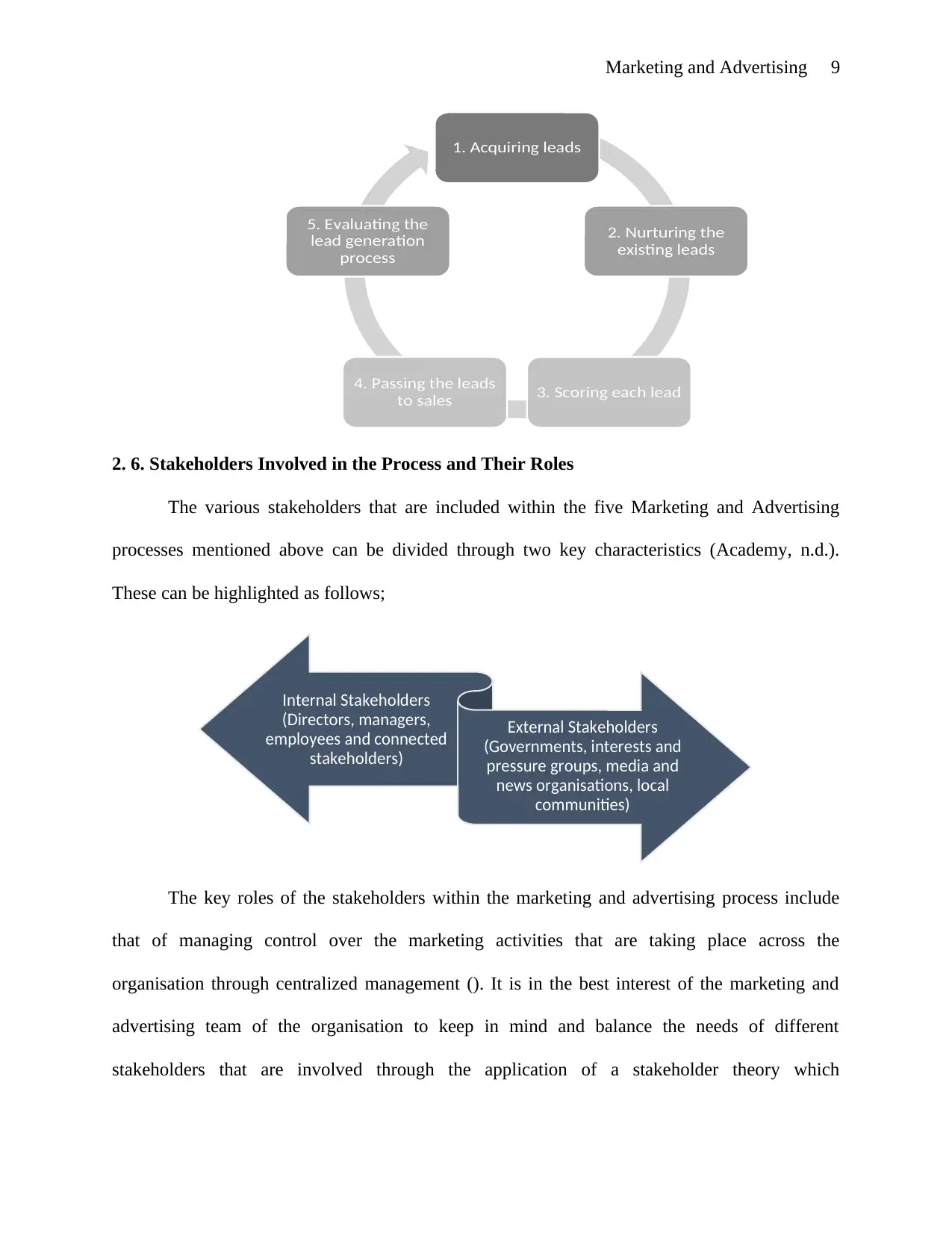
Marketing and Advertising 9
2. 6. Stakeholders Involved in the Process and Their Roles
The various stakeholders that are included within the five Marketing and Advertising
processes mentioned above can be divided through two key characteristics (Academy, n.d.).
These can be highlighted as follows;
The key roles of the stakeholders within the marketing and advertising process include
that of managing control over the marketing activities that are taking place across the
organisation through centralized management (). It is in the best interest of the marketing and
advertising team of the organisation to keep in mind and balance the needs of different
stakeholders that are involved through the application of a stakeholder theory which
1. Acquiring leads
2. Nurturing the
existing leads
3. Scoring each lead
4. Passing the leads
to sales
5. Evaluating the
lead generation
process
Internal Stakeholders
(Directors, managers,
employees and connected
stakeholders)
External Stakeholders
(Governments, interests and
pressure groups, media and
news organisations, local
communities)
2. 6. Stakeholders Involved in the Process and Their Roles
The various stakeholders that are included within the five Marketing and Advertising
processes mentioned above can be divided through two key characteristics (Academy, n.d.).
These can be highlighted as follows;
The key roles of the stakeholders within the marketing and advertising process include
that of managing control over the marketing activities that are taking place across the
organisation through centralized management (). It is in the best interest of the marketing and
advertising team of the organisation to keep in mind and balance the needs of different
stakeholders that are involved through the application of a stakeholder theory which
1. Acquiring leads
2. Nurturing the
existing leads
3. Scoring each lead
4. Passing the leads
to sales
5. Evaluating the
lead generation
process
Internal Stakeholders
(Directors, managers,
employees and connected
stakeholders)
External Stakeholders
(Governments, interests and
pressure groups, media and
news organisations, local
communities)
You're viewing a preview
Unlock full access by subscribing today!
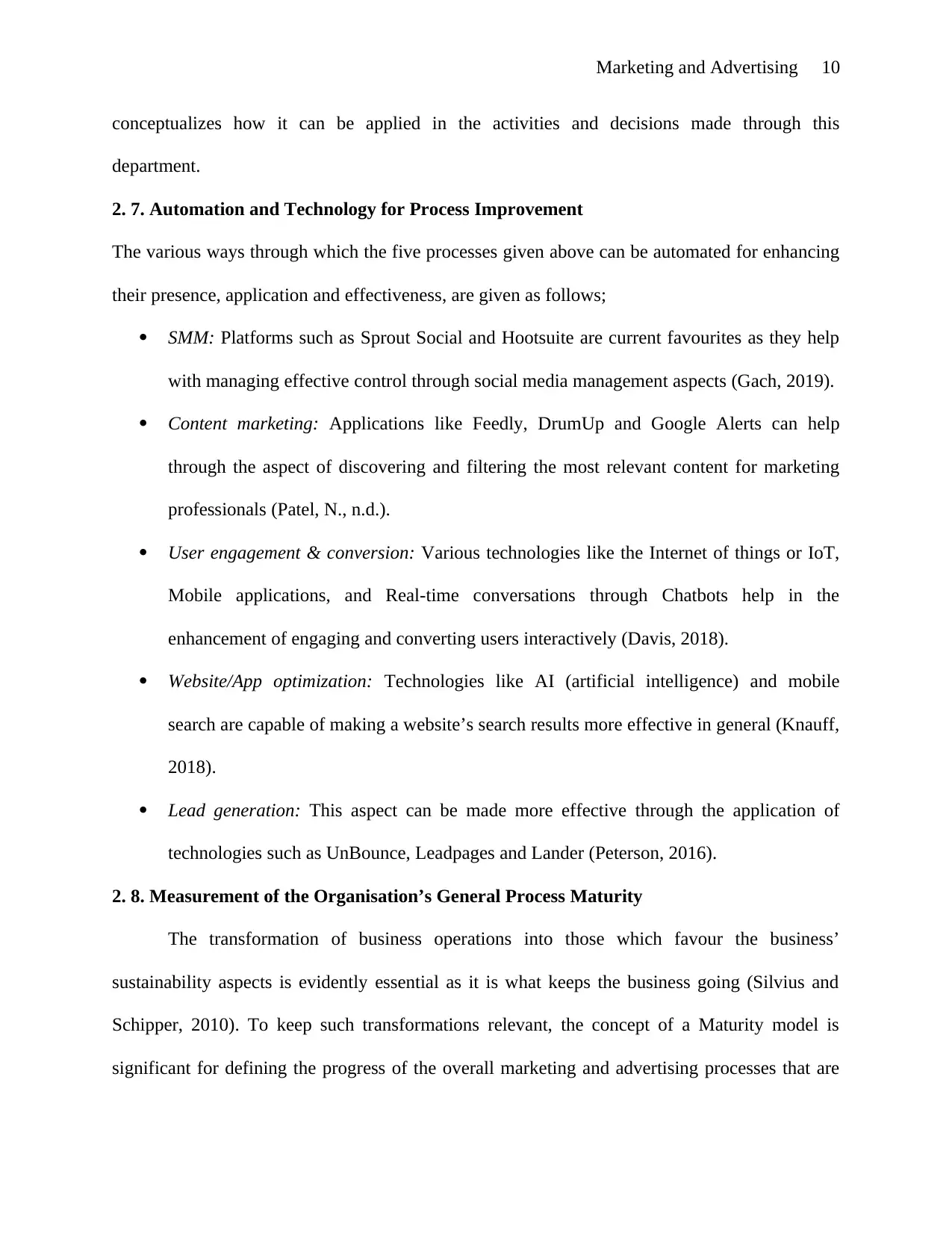
Marketing and Advertising 10
conceptualizes how it can be applied in the activities and decisions made through this
department.
2. 7. Automation and Technology for Process Improvement
The various ways through which the five processes given above can be automated for enhancing
their presence, application and effectiveness, are given as follows;
SMM: Platforms such as Sprout Social and Hootsuite are current favourites as they help
with managing effective control through social media management aspects (Gach, 2019).
Content marketing: Applications like Feedly, DrumUp and Google Alerts can help
through the aspect of discovering and filtering the most relevant content for marketing
professionals (Patel, N., n.d.).
User engagement & conversion: Various technologies like the Internet of things or IoT,
Mobile applications, and Real-time conversations through Chatbots help in the
enhancement of engaging and converting users interactively (Davis, 2018).
Website/App optimization: Technologies like AI (artificial intelligence) and mobile
search are capable of making a website’s search results more effective in general (Knauff,
2018).
Lead generation: This aspect can be made more effective through the application of
technologies such as UnBounce, Leadpages and Lander (Peterson, 2016).
2. 8. Measurement of the Organisation’s General Process Maturity
The transformation of business operations into those which favour the business’
sustainability aspects is evidently essential as it is what keeps the business going (Silvius and
Schipper, 2010). To keep such transformations relevant, the concept of a Maturity model is
significant for defining the progress of the overall marketing and advertising processes that are
conceptualizes how it can be applied in the activities and decisions made through this
department.
2. 7. Automation and Technology for Process Improvement
The various ways through which the five processes given above can be automated for enhancing
their presence, application and effectiveness, are given as follows;
SMM: Platforms such as Sprout Social and Hootsuite are current favourites as they help
with managing effective control through social media management aspects (Gach, 2019).
Content marketing: Applications like Feedly, DrumUp and Google Alerts can help
through the aspect of discovering and filtering the most relevant content for marketing
professionals (Patel, N., n.d.).
User engagement & conversion: Various technologies like the Internet of things or IoT,
Mobile applications, and Real-time conversations through Chatbots help in the
enhancement of engaging and converting users interactively (Davis, 2018).
Website/App optimization: Technologies like AI (artificial intelligence) and mobile
search are capable of making a website’s search results more effective in general (Knauff,
2018).
Lead generation: This aspect can be made more effective through the application of
technologies such as UnBounce, Leadpages and Lander (Peterson, 2016).
2. 8. Measurement of the Organisation’s General Process Maturity
The transformation of business operations into those which favour the business’
sustainability aspects is evidently essential as it is what keeps the business going (Silvius and
Schipper, 2010). To keep such transformations relevant, the concept of a Maturity model is
significant for defining the progress of the overall marketing and advertising processes that are
Paraphrase This Document
Need a fresh take? Get an instant paraphrase of this document with our AI Paraphraser
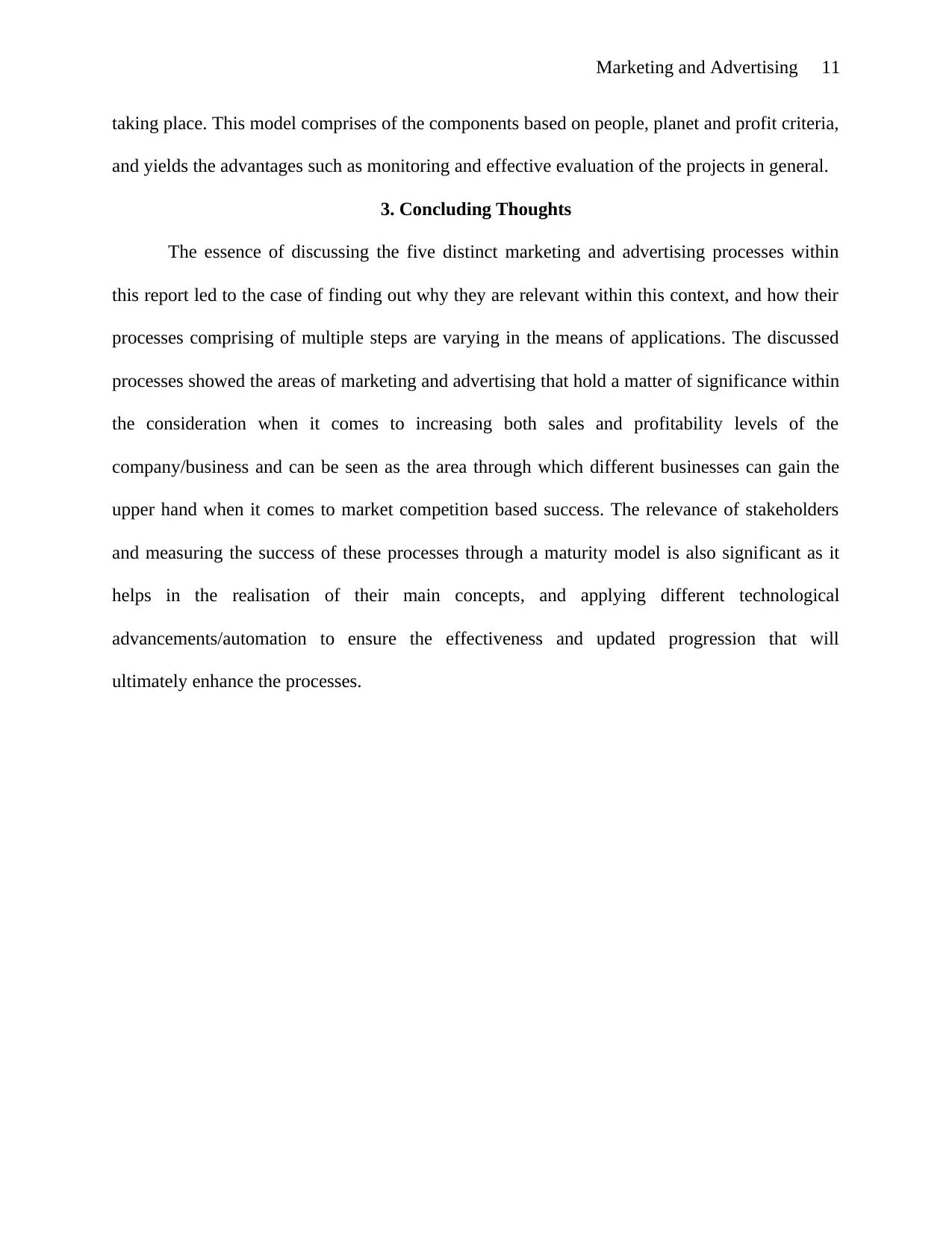
Marketing and Advertising 11
taking place. This model comprises of the components based on people, planet and profit criteria,
and yields the advantages such as monitoring and effective evaluation of the projects in general.
3. Concluding Thoughts
The essence of discussing the five distinct marketing and advertising processes within
this report led to the case of finding out why they are relevant within this context, and how their
processes comprising of multiple steps are varying in the means of applications. The discussed
processes showed the areas of marketing and advertising that hold a matter of significance within
the consideration when it comes to increasing both sales and profitability levels of the
company/business and can be seen as the area through which different businesses can gain the
upper hand when it comes to market competition based success. The relevance of stakeholders
and measuring the success of these processes through a maturity model is also significant as it
helps in the realisation of their main concepts, and applying different technological
advancements/automation to ensure the effectiveness and updated progression that will
ultimately enhance the processes.
taking place. This model comprises of the components based on people, planet and profit criteria,
and yields the advantages such as monitoring and effective evaluation of the projects in general.
3. Concluding Thoughts
The essence of discussing the five distinct marketing and advertising processes within
this report led to the case of finding out why they are relevant within this context, and how their
processes comprising of multiple steps are varying in the means of applications. The discussed
processes showed the areas of marketing and advertising that hold a matter of significance within
the consideration when it comes to increasing both sales and profitability levels of the
company/business and can be seen as the area through which different businesses can gain the
upper hand when it comes to market competition based success. The relevance of stakeholders
and measuring the success of these processes through a maturity model is also significant as it
helps in the realisation of their main concepts, and applying different technological
advancements/automation to ensure the effectiveness and updated progression that will
ultimately enhance the processes.
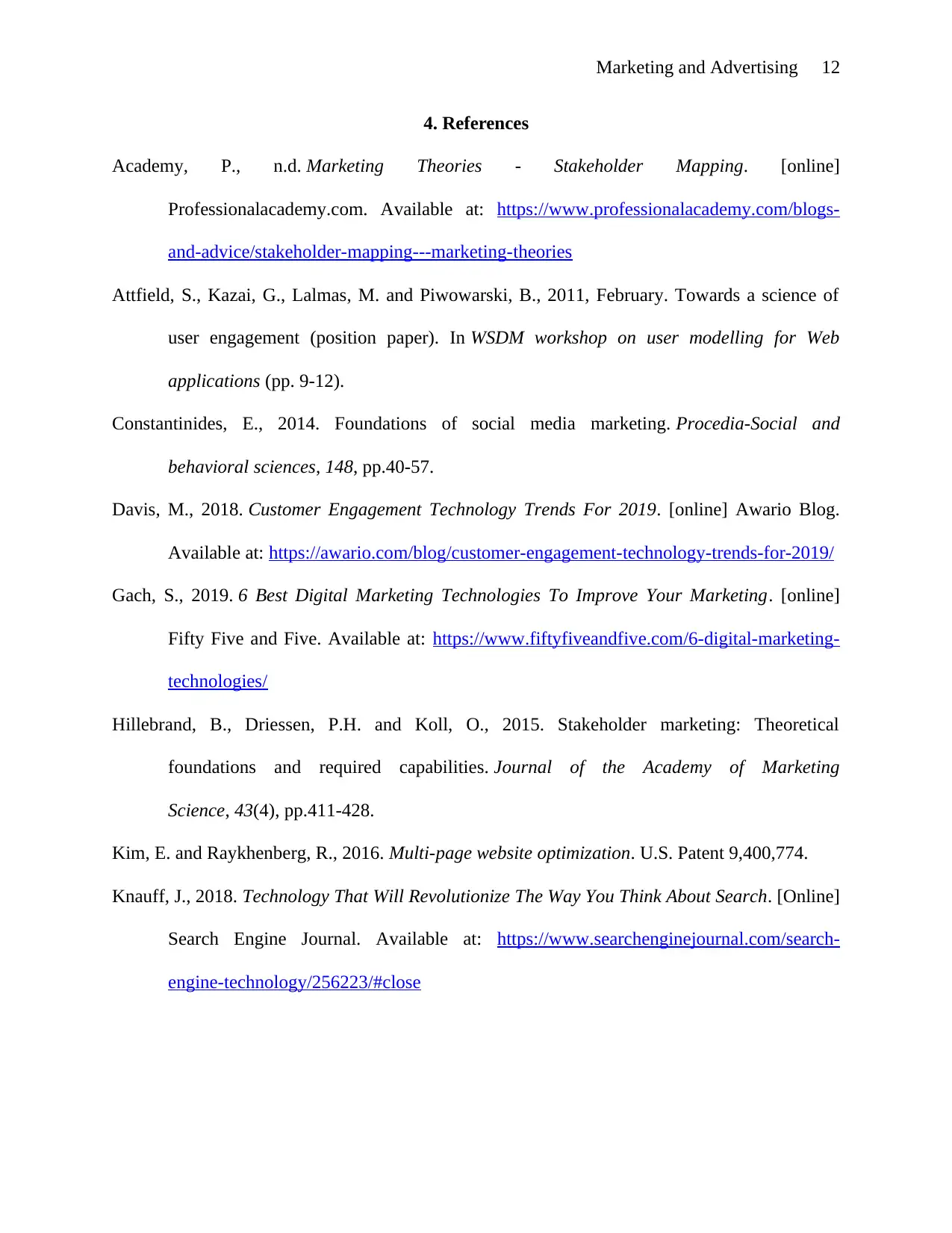
Marketing and Advertising 12
4. References
Academy, P., n.d. Marketing Theories - Stakeholder Mapping. [online]
Professionalacademy.com. Available at: https://www.professionalacademy.com/blogs-
and-advice/stakeholder-mapping---marketing-theories
Attfield, S., Kazai, G., Lalmas, M. and Piwowarski, B., 2011, February. Towards a science of
user engagement (position paper). In WSDM workshop on user modelling for Web
applications (pp. 9-12).
Constantinides, E., 2014. Foundations of social media marketing. Procedia-Social and
behavioral sciences, 148, pp.40-57.
Davis, M., 2018. Customer Engagement Technology Trends For 2019. [online] Awario Blog.
Available at: https://awario.com/blog/customer-engagement-technology-trends-for-2019/
Gach, S., 2019. 6 Best Digital Marketing Technologies To Improve Your Marketing. [online]
Fifty Five and Five. Available at: https://www.fiftyfiveandfive.com/6-digital-marketing-
technologies/
Hillebrand, B., Driessen, P.H. and Koll, O., 2015. Stakeholder marketing: Theoretical
foundations and required capabilities. Journal of the Academy of Marketing
Science, 43(4), pp.411-428.
Kim, E. and Raykhenberg, R., 2016. Multi-page website optimization. U.S. Patent 9,400,774.
Knauff, J., 2018. Technology That Will Revolutionize The Way You Think About Search. [Online]
Search Engine Journal. Available at: https://www.searchenginejournal.com/search-
engine-technology/256223/#close
4. References
Academy, P., n.d. Marketing Theories - Stakeholder Mapping. [online]
Professionalacademy.com. Available at: https://www.professionalacademy.com/blogs-
and-advice/stakeholder-mapping---marketing-theories
Attfield, S., Kazai, G., Lalmas, M. and Piwowarski, B., 2011, February. Towards a science of
user engagement (position paper). In WSDM workshop on user modelling for Web
applications (pp. 9-12).
Constantinides, E., 2014. Foundations of social media marketing. Procedia-Social and
behavioral sciences, 148, pp.40-57.
Davis, M., 2018. Customer Engagement Technology Trends For 2019. [online] Awario Blog.
Available at: https://awario.com/blog/customer-engagement-technology-trends-for-2019/
Gach, S., 2019. 6 Best Digital Marketing Technologies To Improve Your Marketing. [online]
Fifty Five and Five. Available at: https://www.fiftyfiveandfive.com/6-digital-marketing-
technologies/
Hillebrand, B., Driessen, P.H. and Koll, O., 2015. Stakeholder marketing: Theoretical
foundations and required capabilities. Journal of the Academy of Marketing
Science, 43(4), pp.411-428.
Kim, E. and Raykhenberg, R., 2016. Multi-page website optimization. U.S. Patent 9,400,774.
Knauff, J., 2018. Technology That Will Revolutionize The Way You Think About Search. [Online]
Search Engine Journal. Available at: https://www.searchenginejournal.com/search-
engine-technology/256223/#close
You're viewing a preview
Unlock full access by subscribing today!
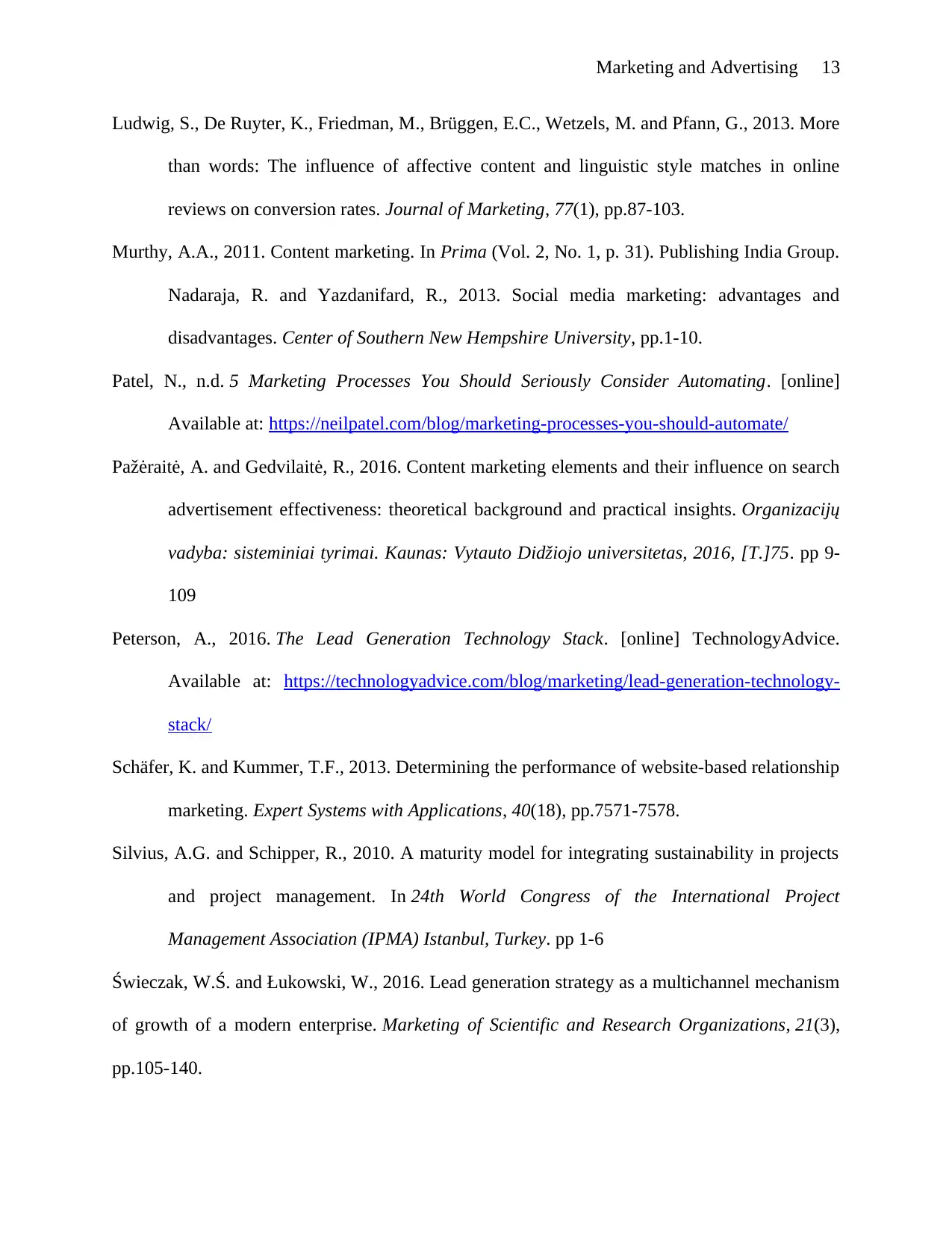
Marketing and Advertising 13
Ludwig, S., De Ruyter, K., Friedman, M., Brüggen, E.C., Wetzels, M. and Pfann, G., 2013. More
than words: The influence of affective content and linguistic style matches in online
reviews on conversion rates. Journal of Marketing, 77(1), pp.87-103.
Murthy, A.A., 2011. Content marketing. In Prima (Vol. 2, No. 1, p. 31). Publishing India Group.
Nadaraja, R. and Yazdanifard, R., 2013. Social media marketing: advantages and
disadvantages. Center of Southern New Hempshire University, pp.1-10.
Patel, N., n.d. 5 Marketing Processes You Should Seriously Consider Automating. [online]
Available at: https://neilpatel.com/blog/marketing-processes-you-should-automate/
Pažėraitė, A. and Gedvilaitė, R., 2016. Content marketing elements and their influence on search
advertisement effectiveness: theoretical background and practical insights. Organizacijų
vadyba: sisteminiai tyrimai. Kaunas: Vytauto Didžiojo universitetas, 2016, [T.]75. pp 9-
109
Peterson, A., 2016. The Lead Generation Technology Stack. [online] TechnologyAdvice.
Available at: https://technologyadvice.com/blog/marketing/lead-generation-technology-
stack/
Schäfer, K. and Kummer, T.F., 2013. Determining the performance of website-based relationship
marketing. Expert Systems with Applications, 40(18), pp.7571-7578.
Silvius, A.G. and Schipper, R., 2010. A maturity model for integrating sustainability in projects
and project management. In 24th World Congress of the International Project
Management Association (IPMA) Istanbul, Turkey. pp 1-6
Świeczak, W.Ś. and Łukowski, W., 2016. Lead generation strategy as a multichannel mechanism
of growth of a modern enterprise. Marketing of Scientific and Research Organizations, 21(3),
pp.105-140.
Ludwig, S., De Ruyter, K., Friedman, M., Brüggen, E.C., Wetzels, M. and Pfann, G., 2013. More
than words: The influence of affective content and linguistic style matches in online
reviews on conversion rates. Journal of Marketing, 77(1), pp.87-103.
Murthy, A.A., 2011. Content marketing. In Prima (Vol. 2, No. 1, p. 31). Publishing India Group.
Nadaraja, R. and Yazdanifard, R., 2013. Social media marketing: advantages and
disadvantages. Center of Southern New Hempshire University, pp.1-10.
Patel, N., n.d. 5 Marketing Processes You Should Seriously Consider Automating. [online]
Available at: https://neilpatel.com/blog/marketing-processes-you-should-automate/
Pažėraitė, A. and Gedvilaitė, R., 2016. Content marketing elements and their influence on search
advertisement effectiveness: theoretical background and practical insights. Organizacijų
vadyba: sisteminiai tyrimai. Kaunas: Vytauto Didžiojo universitetas, 2016, [T.]75. pp 9-
109
Peterson, A., 2016. The Lead Generation Technology Stack. [online] TechnologyAdvice.
Available at: https://technologyadvice.com/blog/marketing/lead-generation-technology-
stack/
Schäfer, K. and Kummer, T.F., 2013. Determining the performance of website-based relationship
marketing. Expert Systems with Applications, 40(18), pp.7571-7578.
Silvius, A.G. and Schipper, R., 2010. A maturity model for integrating sustainability in projects
and project management. In 24th World Congress of the International Project
Management Association (IPMA) Istanbul, Turkey. pp 1-6
Świeczak, W.Ś. and Łukowski, W., 2016. Lead generation strategy as a multichannel mechanism
of growth of a modern enterprise. Marketing of Scientific and Research Organizations, 21(3),
pp.105-140.
1 out of 13
Related Documents
Your All-in-One AI-Powered Toolkit for Academic Success.
+13062052269
info@desklib.com
Available 24*7 on WhatsApp / Email
![[object Object]](/_next/static/media/star-bottom.7253800d.svg)
Unlock your academic potential
© 2024 | Zucol Services PVT LTD | All rights reserved.


